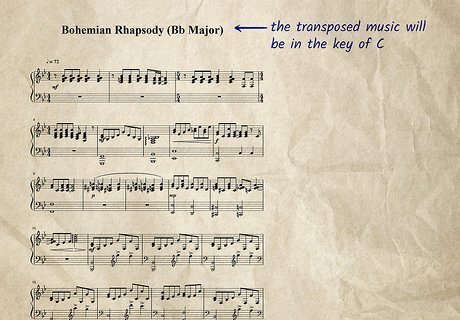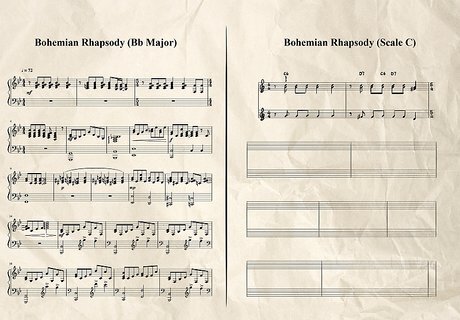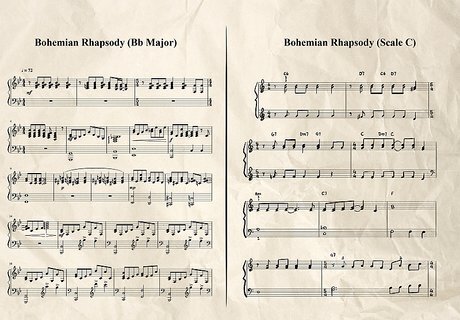
views
- First, raise your key signature by 1 whole step. If the original music is in C major, for example, the transposed music will be in D major (D is a whole step above C).
- Then, raise each note of the music up 1 whole step to fit in the new key. Notes that have accidentals in the original key will also have them in the new key.
- B-flat instruments must transpose a whole step higher because they are pitched a whole step lower than concert instruments, or instruments pitched in C.
Transposing Music in C for B-flat Instruments

Shift your key signature up 1 whole step to determine your new key. Because a Bb instrument sounds 1 whole step lower than what’s written, raise the entire key signature of your music 1 whole step higher to put your instrument in the right key. A whole step is an interval that’s also called a major 2nd (think of the interval between the first 2 notes of a major scale). A whole step is 2 half steps wide, or the interval of 2 adjacent keys on the piano keyboard. Let's say your music is written in Bb major. One whole step up from Bb is C, so you’ll write your transposed music in the key of C. If the original music were written in the key of C major, you would write the transposed music a whole step higher in the key of D, etc.

Write your new key signature on a piece of blank staff paper. Now that you know what new key you’re in, write out the corresponding sharps or flats on the staff at the very left end of each line of music. Review a Circle of Fifths chart to get faster at recalling key signatures from memory. Or, remember these tricks: Raising a key by a whole step is the same as adding 2 sharps to your original key signature. For example, G major transposed up a whole step is A major. G major has 1 sharp (F#), while A major has 3 sharps (F#, C#, and G#). The order of sharps in a key signature is F, C, G, D, A, E, B. Raising a key by a whole step is the same as subtracting 2 flats from your key signature. For example, Eb major transposed up a whole step results in F major. Eb major has 3 flats (Bb, Eb, and Ab), while F major has 1 flat (Bb). The order of flats in a key signature is B, E, A, D, G, C, F (the reverse order of the sharps). Sometimes, you’ll shift from a flat key to a sharp one. For example, if the concert key is F major, with a Bb in the key signature, you’ll end up in G major, with an F# in the key signature.

Transpose each note of the music up a whole step to fit in the new key. Now that you’ve got your key signature set, it’s time to transpose the actual tune! Raise each note of the music up a whole step and write in the new note on your staff paper. Since you have the key signature penciled in, you don’t need to write out sharp or flat signs next to diatonic notes (notes that belong in the key signature). For example, if your new key signature has C# in it and you’re transposing the note B, which becomes a C#, just draw in a C without a sharp sign. If the original note has an accidental (a sharp, flat, or natural sign that does not belong to the key signature), make sure that the transposed note also has an accidental in the new key. For example, if you have a G# note in D major (which only indicates F# and C# in the key signature), then you’ll write A# in the new key of E (which has F#, C#, G#, and D# in its key signature). If you’re transposing by sight, think up a whole step for each note while you read the original music. Play slowly at first—transposing by sight is a skill that takes patience and practice!

Try music notation software to transpose lots of music quickly. Transposing short passages by sight or by writing them out by hand is a nifty skill to have, but isn’t very convenient if you have to transpose an entire symphony’s worth of music. For big projects, try using music notation software like MuseScore or Finale. Each program works slightly differently, but the general process is the same: First, upload the music you want to transpose and indicate that it’s pitched in C. Some programs let you upload a scan of the music, while you might have to manually enter the music note-by-note in others. Then, go into the score settings for your project and follow your program’s instructions to transpose. In most cases, it’s as easy as selecting the key you want to transpose to and clicking a button!
How do transposing instruments work?

Transposing instruments play in a different key to match pitch with C instruments. Compare a piano, which is pitched in C (or “concert pitch”), to a clarinet pitched in B-flat. When a piano player reads and plays a C, the note that you hear is a C. When a clarinet player plays a C, however, the note you hear is a Bb. Since a Bb sounds a whole step lower than a C, the clarinet player needs to transpose, or “shift,” their music a whole step higher to compensate and match the piano (or any other C instrument, like the flute or violin). Ensemble parts for transposing instruments must be written in different keys so that C instruments and non-C instruments can play in harmony together correctly. Otherwise, if transposing instruments were to play parts written in C, the group would be playing in multiple key signatures at once! Historically, some wind instruments could only play in certain keys due to limitations in instrument-making technology or because certain keys just sounded better on some instruments. Today, we keep the transposing versions of these instruments so that players don’t have to relearn fingers and technique when switching between related instruments (for example, jumping between a B-flat and E-flat clarinets).
Which instruments are pitched in B-flat?

Common B-flat instruments include clarinet, trumpet, and tenor sax. Most B-flat transposing instruments are “band instruments,” or woodwind and brass instruments that often appear in a concert or marching band setting (but several can appear in orchestras, too). Some B-flat instruments, like the bass clarinet or tenor sax, also play 1 octave lower than written (or a major 9th lower than concert pitch). B-flat instruments you’ll encounter include: Trumpet and cornet (note that trumpets can come in a variety of keys) Soprano, tenor, and bass saxophone B-flat clarinet Bass and contrabass clarinet Treble clef baritone and euphonium Flugelhorn and sousaphone

















Comments
0 comment